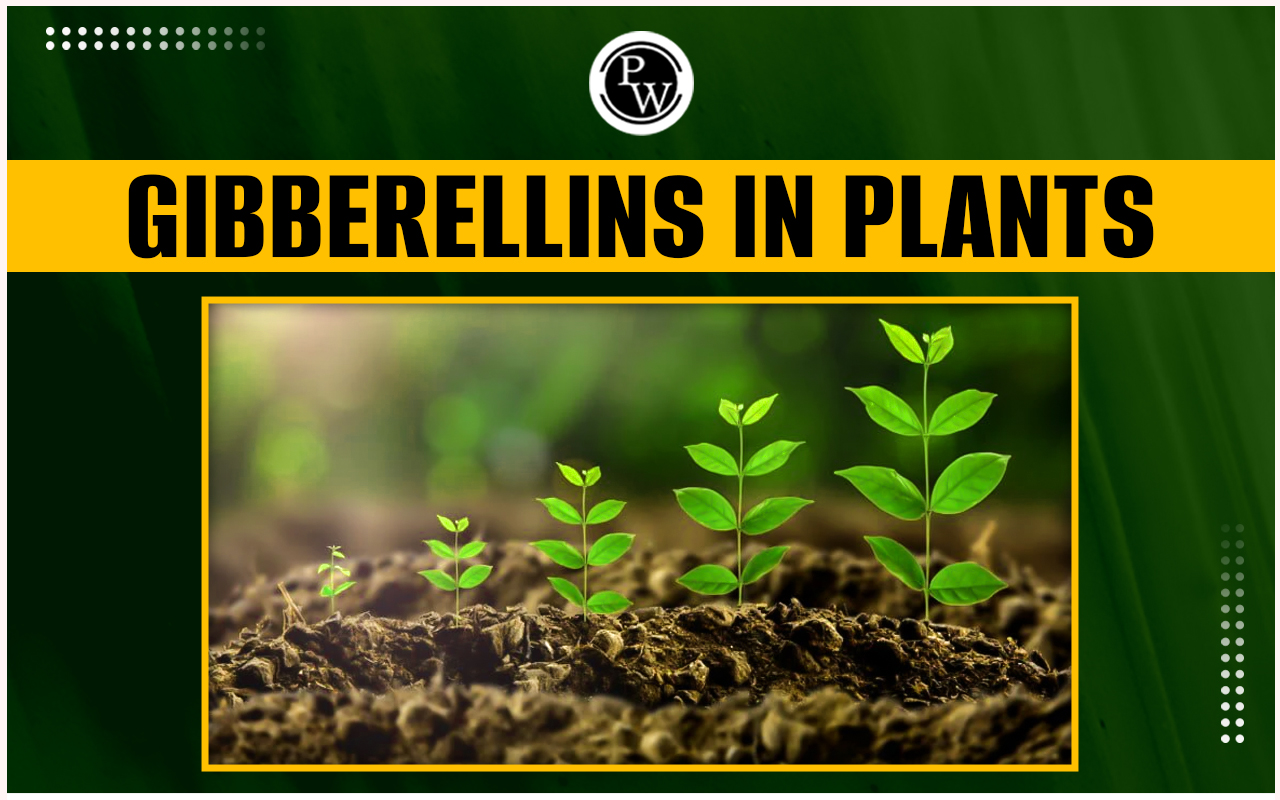

Gibberellins in Plants: Gibberellins are plant growth regulators essential for plant development. Plant growth regulators are chemicals released in the body that control the plant's life cycle. This article will discuss gibberellins' structure, role, and function in plants.
Gibberellins cause the seeds of plants that need exposure to cold or light to germinate to emerge from dormancy, a condition of limited growth and development. Some plant species' seeds require water to germinate before they may grow. Water intake activates gibberellins, which signals the gene-producing amylase to be transcribed. Amylase is an enzyme that converts starches contained in seeds into simple sugars (notice that these last two processes are the same as those in phytochrome-regulated germination). Gibberellins encourage immature roots' cell elongation during germination. Abscisic acid, a hormone that suppresses gibberellin activity, prevents germination in this route when water is not present. Gibberellins and abscisic acid, therefore, work counter to one another to control the germination response.Plant Growth Regulators
Plant growth regulators are artificial or organic substances that alter the metabolic or developmental processes of in vitro-cultured plant tissues. The word "phytohormones" is frequently used to refer to the substances that plants naturally make. Synthetic hormone analogues, however, are not regarded as phytohormones. Plant growth regulators are crucial because they control and modify how plants grow by changing some aspects of their growth, including blooming, fruit ripening, plant height, and the development of their seeds. Plant growth regulators regulate all facets of morphology and development in nature. Plant growth regulators also assist plants in coping with environmental shocks and changes. Plant growth regulators can be introduced in biotechnology to increase plant fruit quality, plant survival, and plant propagation for breeding. The five central plant growth regulators are ethylene, auxins, cytokinins, gibberellins, and abscisic acid. Every plant growth regulator works uniquely. Auxins, for instance, cause calli. Cytokinins promote cell division. Gibberellins, particularly in adventitious roots, induce organogenesis. Germination and maturation are aided by abscisic acid. And the primary factor controlling fruit ripening is ethylene.Genetically Modified Organisms Ethical Issues
The typical Plant Growth Regulators' in vitro activities are listed below.Auxins
- Create a callus from explants (the section of plant tissue utilised in culture procedures), masses of undifferentiated cells.
- Favours the biological process through which a cell, tissue, or organism takes on its shape, known as root and shoot morphogenesis.
- They are more efficient when coupled with cytokinins.
Cytokinins
- Encouraging cell division.
- Lateral bud dormancy (dormant bud) is released.
- Induces the emergence of adventitious buds.
- Often prevents root induction and development.
Gibberellins
- Encourage the development of organs, especially adventitious roots.
- Impede the growth of roots, shoots, and embryos.
Benzoic Acid
- Favours somatic embryogenesis maturation and germination
- Inhibits organogenesis (the formation of buds, roots, and embryos) and callus growth at high doses.
- Encourages somatic embryo maturation and proper development
- Increases the resistance of growing plants and cell cultures to freezing.
Ethylene
- It is naturally synthesised in plant cultures and is utilised less frequently.
- It promotes tissue maturation when utilised.
- Ethylene may either promote or prevent development and organogenesis depending on how long it has been after subculture.
- It impacts embryogenesis, axillary and adventitious bud development, stem and root elongation, callus and suspension culture growth, and more.
Gibberellins in Plants
Gibberellin is a phytohormone composed of cyclic diterpenes found in seeds, young leaves, and roots. Gibberellins, or Gibberellic acid, abbreviated as GA, are intercellular factors promoting meristematic growth, elongation, and plant maturation. The first GA was discovered in the study of ‘bakane disease of rice seedlings’ using Gibberella fujikuroi , a fungus that produces GA . Gibberellins are a type of promotive plant growth regulators associated with breaking seed dormancy and seed germination. Gibberellins in plants are diterpenoid phytohormones that regulate cell elongation, stimulating flowering and bolting in plants.Gibberellin: Structure
- Gibberellin is a diterpenoid phytohormone with a tetracyclic carboxylic structure. Gibberellins in plants are acidic.
- Numerous areas of the plant produce distinct forms of gibberellin molecules. There are currently more than 100 distinct gibberellin molecules.
- The plant produces these chemicals in a variety of cell types, although they are primarily concentrated in the roots. This is different from auxin, which concentrates at the apex.
- Gibberellin is a diterpenoid, a well-known and frequently occurring chemical in biochemistry. It is the building block for compounds like vitamins A and E.
- Although they have different side groups attached, other gibberellins share the same core structure. These groups impact where and how gibberellin operates, which explains why it may have a wide range of distinct roles in various tissues.
Role of Gibberellin in Plant
Seedling Emergence
- Since a dormant seed is dry, very little metabolic activity may occur. A seed can normally grow for a long time because of this. After surviving the winter, most seeds are exposed to rain in the spring. This water completely saturates the seed and restarts metabolic activity. Gibberellin is a hormone that is crucial to this process.
- The embryo requires more energy as it starts to expand. The embryo releases gibberellin molecules and goes to the aleurone layer, which encircles the endosperm. The endosperm is a substantial mass of cells that serves as the growing embryo's source of carbohydrates, lipids, and proteins. When the gibberellin molecules signal, the aleurone layer starts manufacturing the enzymes needed to break down the endosperm and feed the developing embryo.
- Most of the gibberellin molecules' pathways affect boost DNA transcription for specific genes that generate the necessary enzymes. Amylase enzymes are released by the aleurone layer, turning the starch molecules into glucose.
- The developing embryo's primary energy source is glucose, which it cannot create through photosynthesis as it has not yet sprouted. Additionally, the release of lipases, which disassemble lipid molecules like fats and oils, and proteases, which break down proteins into amino acids, is stimulated by gibberellin molecules.
- These enzymes work together to break down the endosperm, which enables the embryo to develop quickly.
Stem Expansion and Other Purposes
- The endosperm disappears long after a plant emerges from the soil's surface. Now, for sustenance, the plant must rely on photosynthesis. Gibberellin's function extends beyond the seed, though. Many facets of plant growth are regulated by gibberellin. Additionally, plants generate a variety of gibberellin molecules that have an impact on various plant sections.
- The hormone gibberellin promotes plants to lengthen their internodes or the distance between their leaves. Gibberellin regulation in many plants is a crucial natural mechanism that controls their height due to this process. Gibberellin affects the equilibrium of proteins on a cellular level. As a result, it promotes cell elongation and proliferation in stems and between nodes.
- Gibberellin is involved in many additional activities in various plant species. These consist of fruiting, blooming, and senescence, the eventual natural demise of leaves and other plant components. Interestingly, temperature impacts numerous genes that control and modify gibberellin levels. Therefore, the plants respond to temperature fluctuations throughout seasonal shifts by changing gibberellin levels. Many processes, including blooming and fruiting, are initiated by this.
- Other plant hormones are associated with and interact with gibberellin molecules. For instance, the levels of auxin and gibberellin are intimately correlated and work in harmony. On the other side, gibberellin levels are often reduced by ethylene. These hormones, which have varied responses, are used by plants to maintain balance and adapt to environmental inputs. The plant is eager to utilise these inputs' varied environmental circumstances.
Commercial Uses
- Gibberellin is derived from fungi, not plants, for commercial purposes. Compared to fungi, plants generate relatively little gibberellin and are thus challenging to grow. The gibberellin that fungi generate is active in plants and can stimulate seed germination or lengthen internodes. Gibberellin treatments are applied to various human foods, even though they are not yet financially lucrative in all plants.
- For instance, seedless grapes struggle to grow particularly large without applying gibberellin treatments. Usually, gibberellin molecules are sprayed onto the vines, increasing the quantity of water and sugar that each fruit can hold. The harvest of vineyards and grape farmers will increase significantly, which is fantastic.
- Interestingly, gibberellin has another use removing it from plants. Selection favouring strains in which the genetic codes for generating gibberellin molecules were eliminated led to the developing of semi-dwarf rice, a species that develops swiftly and effectively. As a result, the plants' gibberellin levels were effectively depleted, and their height was greatly diminished.
- Even though this might sound unpleasant, the rice grows faster and produces the same amount of rice. Gibberellin is also used on cucumber blossoms to encourage all-male blooms, among other things. As a result, growers can get pollen from a favoured cultivar for use in cross-pollination with other types. Gibberellin has an underutilised yet intriguing use in removing the need for cold flowers.
Genetic Code Codons Amino Acids
Gibberellin's Mode of Action
- Gibberellins, like auxins, often speed up longitudinal cell growth and cell division. Similar to auxin, gibberellins likewise affect gene transcription by blocking the pathway's inhibitor (a double-negative is positive); this is how they work to activate a pathway. First, gibberellin enters the cell and interacts with the soluble receptor protein GID1 (also known as the "gibberellin-insensitive dwarf mutant 1"). GID1 can then join a complex of proteins (SCF) that attaches ubiquitin to one or more DELLA proteins. The DELLA proteins are then targeted for degradation by proteasomes as a result.
- This causes proteasomes to start destroying the DELLA proteins. Normal DELLA proteins bind gibberellin-dependent transcription factors; one notable one is PIF3/4, preventing them from interacting with the DNA of genes with gibberellin-activated control sequences.
- GA-related mutations can be found in the dwarf cultivars of wheat and rice. The mutation prevents the production of gibberellins in the case of rice. The DELLA protein gene in wheat has undergone a reduction due to the wheat mutation, which also affects the plant's capacity to react to its gibberellins. There are also dwarf strains of sorghum and, more recently, maize (corn), although, in these instances, the mutation affects auxin transport rather than gibberellin activity.
Effects of Air Pollution on Plants
1. What are plant growth regulators?
Plant growth regulators, or PGRs, are plant hormones that chemically regulate the physiological functions in the plant body.
2. What is Gibberellin?
Gibberellin is a phytohormone that regulates seed dormancy and germination. Gibberellins are abbreviated as GA, and there are more than 100 varieties of GA in plants.
3. How were Gibberellins in plants discovered?
Gibberellins were discovered in the bakene disease in the rice experiment. As a part of this experiment, it was found that strains from Gibberella fujikuroi infected the healthy seedlings, and gibberellins were discovered.
4. What is the function of Gibberellins in plants?
Gibberellins regulate the duration of seed dormancy. They are essential for germinating a seed into a radicle and plumule. It is also responsible for cell elongation and bolting.
🔥 Trending Blogs
Talk to a counsellorHave doubts? Our support team will be happy to assist you!

Check out these Related Articles
Free Learning Resources
PW Books
Notes (Class 10-12)
PW Study Materials
Notes (Class 6-9)
Ncert Solutions
Govt Exams
Class 6th to 12th Online Courses
Govt Job Exams Courses
UPSC Coaching
Defence Exam Coaching
Gate Exam Coaching
Other Exams
Know about Physics Wallah
Physics Wallah is an Indian edtech platform that provides accessible & comprehensive learning experiences to students from Class 6th to postgraduate level. We also provide extensive NCERT solutions, sample paper, NEET, JEE Mains, BITSAT previous year papers & more such resources to students. Physics Wallah also caters to over 3.5 million registered students and over 78 lakh+ Youtube subscribers with 4.8 rating on its app.
We Stand Out because
We provide students with intensive courses with India’s qualified & experienced faculties & mentors. PW strives to make the learning experience comprehensive and accessible for students of all sections of society. We believe in empowering every single student who couldn't dream of a good career in engineering and medical field earlier.
Our Key Focus Areas
Physics Wallah's main focus is to make the learning experience as economical as possible for all students. With our affordable courses like Lakshya, Udaan and Arjuna and many others, we have been able to provide a platform for lakhs of aspirants. From providing Chemistry, Maths, Physics formula to giving e-books of eminent authors like RD Sharma, RS Aggarwal and Lakhmir Singh, PW focuses on every single student's need for preparation.
What Makes Us Different
Physics Wallah strives to develop a comprehensive pedagogical structure for students, where they get a state-of-the-art learning experience with study material and resources. Apart from catering students preparing for JEE Mains and NEET, PW also provides study material for each state board like Uttar Pradesh, Bihar, and others
Copyright © 2025 Physicswallah Limited All rights reserved.
Get App











